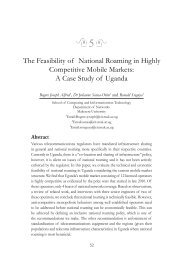Benjamin Kanagwa, Joab Agaba, Doreen Tuheirwe and Susan ...
Benjamin Kanagwa, Joab Agaba, Doreen Tuheirwe and Susan ...
Benjamin Kanagwa, Joab Agaba, Doreen Tuheirwe and Susan ...
Create successful ePaper yourself
Turn your PDF publications into a flip-book with our unique Google optimized e-Paper software.
Part 6: Improving Learning objects reusability through automatic generation web services 503<br />
unprecedented rate of mobile phone penetration, e-learning is yet to reach its peak. Key<br />
to e-learning systems is the need to re-use existing learning resources to build larger <strong>and</strong><br />
improved learning resources. To support this need, researchers in e-learning technologies<br />
have focused on interoperability, transportability <strong>and</strong> re-use improvement powered by<br />
the evolution of metadata st<strong>and</strong>ards such as IEEE LOM <strong>and</strong> ADL SCORM. However,<br />
a number of critical issues still remain open that require further attention <strong>and</strong> in-depth<br />
research. First, is that the domain of e-learning has far too many st<strong>and</strong>ards creating a<br />
new interoperability challenge. Secondly, all these have not kept pace with developments<br />
in web infrastructure – the natural home <strong>and</strong> platform for e-learning. For instance, they<br />
do not incorporate modern Web 2.0 techniques where the web is seen as an interactive<br />
environment rather than a repository of static documents.<br />
Currently, the re-use, growth <strong>and</strong> interoperability of e-learning is premised on the<br />
use of Learning Objects (LO) (Wiley 2000; Downes 2003; Elliott 2004). LOs have been<br />
defi ned by Wiley (Wiley 2000) as “any digital resource that can be re-used to support<br />
learning.” The essence of LOs is to have foundational building blocks for e-learning<br />
content that can be re-used in different contexts. Consequently, an LO is neither built for<br />
a specifi c context nor for a specifi c pedagogical design. This defi nition further indicates<br />
that anything done in learning such as content delivery, learner assessment, interactivity<br />
between learner <strong>and</strong> instructor, among others, can be supported by a learning object.<br />
The st<strong>and</strong>ard for Learning Object Metadata (IEEE 2002) developed by the IEEE’s<br />
Learning Technology St<strong>and</strong>ards Committee (LTSC) defi nes a learning object as “any<br />
entity - digital or non- digital - that may be used for learning, education or training.<br />
A common challenge with learning objects is that the cost of producing effective<br />
teaching <strong>and</strong> learning materials is time consuming (V. Ahmed 2007). There is therefore<br />
need to support maximum reusability to allow for the remixing of LOs. A common<br />
characteristic of learning platforms is that it is diffi cult for learners to fi nd appropriate<br />
educational services such as courses, seminars, <strong>and</strong> web-based training applications.<br />
Corporate <strong>and</strong> independent learners aim to choose educational services from<br />
heterogeneous sources <strong>and</strong> of heterogeneous quality. However, since an electronic,<br />
world wide infrastructure for the mediation of educational service offerings is missing,<br />
learners’ choices of educational services are limited towards pre-selected catalogues.<br />
It is still very diffi cult to orchestrate a combination of learning objectives to deliver a<br />
bigger learning goal.<br />
Web services provide a means of organizing services to utilize distributed capabilities.<br />
They support means to publish, discover <strong>and</strong> bind applications through well-defi ned<br />
interfaces. The set of st<strong>and</strong>ards include a st<strong>and</strong>ard specifi cation for public registries<br />
known as Universal Description Discovery <strong>and</strong> Integration (UDDI 2004), a description<br />
language namely Web Services Description Language (WSDL 2007), a distributed<br />
object communication protocol called Simple Object Access Protocol (SOAP 2007)<br />
<strong>and</strong> a dynamic, self-defi ning information specifi cation Language with semantic support<br />
known as eXtended Markup Language (XML). With this set of technologies, web
















